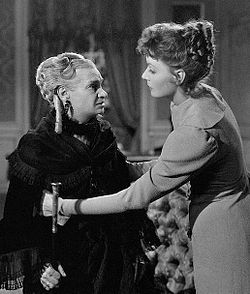Maria Ouspenskaya
Maria Ouspenskaya | |
|---|---|
 Ouspenskaya (left) and Greta Garbo in Conquest (1937) | |
| Born | Maria Alekseyevna Ouspenskaya July 29, 1876 |
| Died | December 3, 1949 (aged 73) Los Angeles, California, U.S. |
| Occupation(s) | Actress Acting teacher |
| Years active | 1915–1949 |
Maria Alekseyevna Ouspenskaya (Russian: Мария Алeкceeвнa Успенская; July 29, 1876 – December 3, 1949) was a Russian actress and acting teacher.[1][2] She achieved success as a stage actress as a young woman in Russia, and as an elderly woman in Hollywood films.[3]
Life and career
Ouspenskaya was born in Tula, Russian Empire, and studied singing in Warsaw, Poland, and acting in Moscow. She was a founding member of the First Studio, a theatre studio of the world-famous Moscow Art Theatre. There she was trained by Konstantin Stanislavsky and his assistant Leopold Sulerzhitsky.[4]
The Moscow Art Theatre traveled widely throughout Europe, and when it arrived in New York City in 1922, Ouspenskaya decided to stay there. She performed regularly on Broadway over the next decade. She taught acting at the American Laboratory Theatre[5] and in 1929, together with Richard Boleslawski, her colleague from the Moscow Art Theatre, she founded the School of Dramatic Art in New York City.[5] One of Ouspenskaya's students at the school during this period was Anne Baxter, then an unknown teenager. [citation needed]
Although she had appeared in a few Russian silent films many years earlier, Ouspenskaya stayed away from Hollywood until her school's financial problems forced her to look for ways to repair her finances. According to ads from Popular Song magazine in the 1930s, around this time Ouspenskaya also opened the Maria Ouspenskaya School of Dance on Vine Street in Los Angeles. Her pupils included Marge Champion, the model for Disney's Snow White.[6]
In spite of her marked Russian accent, she did find work in Hollywood, playing European characters of various national origins. Her first Hollywood role was in Dodsworth (1936), which brought her a nomination for an Academy Award for Best Supporting Actress.[1] (Her onscreen appearance in that film was one of the briefest ever to garner a nomination.) She received a second Oscar nomination for her role in Love Affair (1939).[7]
She portrayed Maleva, an old Gypsy fortuneteller in the horror films The Wolf Man (1941) and Frankenstein Meets the Wolf Man (1943). Other films in which she appeared were: The Rains Came (1939), Waterloo Bridge (1940), Beyond Tomorrow (1940), Dance, Girl, Dance (1940), The Mortal Storm (1940), Dr. Ehrlich's Magic Bullet (1940), and Kings Row (1942).[8]
Death
Ouspenskaya died several days after suffering a stroke and receiving severe burns in a house fire, which was allegedly caused when she fell asleep while smoking a cigarette.[5] She was buried in Glendale's Forest Lawn Memorial Park Cemetery.[9]
Famous quotes
In the film The Wolf Man, Maleva, The Gypsy Woman (played by Maria Ouspenskaya) utters her iconic quote as the Wolf Man is dying:
"The way you walked was thorny, though no fault of your own, but as the rain enters the soil, the river enters the sea, so tears run to a predestined end. Now you will have peace for eternity."
In popular culture
In the Truman Capote novella Breakfast at Tiffany's, Holly Golightly opines diamonds "only look right on the really old girls" and mentions Maria Ouspenskaya.
Selected filmography
- Dodsworth (1936)
- Dr. Ehrlich's Magic Bullet (1940)
- The Mortal Storm (1940)
- The Wolf Man (1941)
- Wyoming (1947)
- A Kiss in the Dark (1949)
References
- ^ a b Robinson, Harlow. 2007. Russians in Hollywood, Hollywood's Russians: Biography of an Image. Boston: Northeastern UP; ISBN 978-1-55553-686-2, page 81
- ^ Nissen, Axel. 2006. Actresses of a Certain Character: Forty Familiar Hollywood Faces from the Thirties to the Fifties. Illustrated ed. Jefferson, NC: McFarland & Co.; ISBN 978-0-7864-2746-8, p. 141.
- ^ Obituary for Maria Ouspenskaya , Variety, December 7, 1949; page 63.
- ^ Benedetti, Jean. Stanislavski: His Life and Art (revised edition, 1999; original edition published in 1988). London: Methuen; ISBN 0-413-52520-1, pp. 209-211
- ^ a b c Smith, Ronald L. (2010). Horror Stars on Radio: The Broadcast Histories of 29 Chilling Hollywood Voices. McFarland & Company. ISBN 978-0-7864-4525-7.
- ^ King, Susan (September 30, 2009). "Marge Champion still has the dance moves". The Los Angeles Times.
- ^ "Academy list its selections". The Palm Beach Post. 1940-02-12. p. 9. Retrieved April 2, 2014.
- ^ Maria Ouspenskaya at IMDb
- ^ Mank, Gregory W. Women in Horror Films, 1940s. 1999. p. 95.
{{cite book}}:|access-date=requires|url=(help)
External links
- 1876 births
- 1949 deaths
- 20th-century American actresses
- 20th-century Russian actresses
- 20th-century educators
- Actresses from Moscow
- American film actresses
- American stage actresses
- Broadway theatre people
- Burials at Forest Lawn Memorial Park (Glendale)
- Deaths from fire in the United States
- Imperial Russian emigrants to the United States
- People from Tula, Russia
- Russian educators
- Russian stage actresses
- Russian silent film actresses
